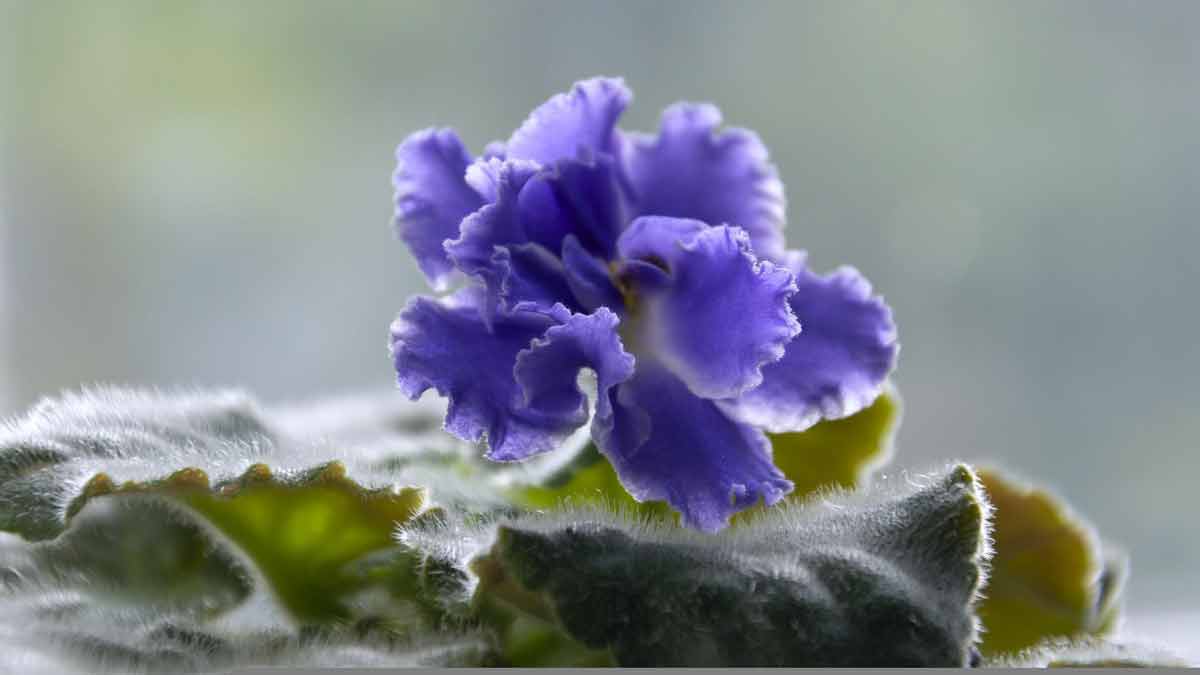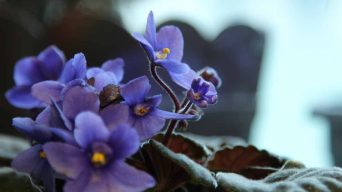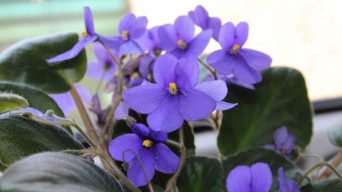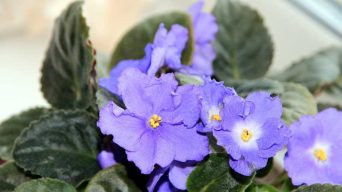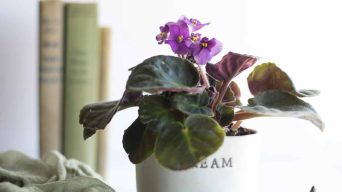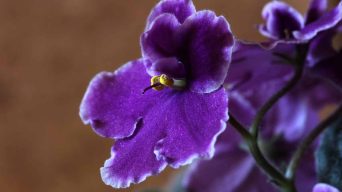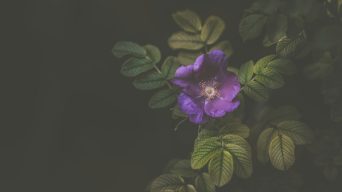White spots on African Violet leaves can result from issues like powdery mildew, pests, nutrient deficiency, hard water minerals, sunburn, or chemical burns. Prevention involves proper care, including watering at the base, regular cleaning, and maintaining ideal conditions. Treat specific problems with remedies like neem oil for pests or a baking soda solution for powdery mildew.
African violets are beautiful, flowering houseplants that brighten up any indoor space.
But if you notice white spots appearing on your plant’s leaves, it can be disconcerting.
There are a few things that can cause white spots on African violet leaves, but luckily, most are fairly easy to fix.
In this article, we’ll go over six possible causes of white spots on African violet leaves and what you can do to solve the problem.
What Causes White Spots on African Violet Leaves?
There are a few different things that can cause white spots to appear on African violet leaves. These include:
1. Powdery Mildew
One of the most common causes of white spots on African violet leaves is powdery mildew.
Powdery mildew is a type of fungal disease that often affects houseplants.
It commonly appears as a white, powdery substance on the leaves of affected plants.
Powdery mildew can be caused by too much humidity, poor air circulation, or overwatering.
It is also more likely to occur if the leaves of your plant are dusty.
How To Tell If Your African Violet Has Powdery Mildew:
Look at the leaves if you think your plant might have powdery mildew.
Do they have a white, powdery substance on them? If so, your plant does likely have this disease.
You should also take note of any other symptoms that are present.
For example, leaves with powdery mildew often look yellow or brown around the edges.
The leaves may also be curled or distorted.
How To Prevent Powdery Mildew
To prevent powdery mildew, ensure to water your plant at the base rather than above.
Increase air circulation around your plant by opening windows or using a fan.
If the humidity in your home is high, you can use a dehumidifier to reduce it.
You should also avoid overcrowding your plants, which can lead to poor air circulation.
Finally, make sure to clean the leaves of your plant regularly with a soft cloth to remove any dust that has accumulated.
How To Treat Powdery Mildew
If your plant does have powdery mildew, there are a few things you can do to treat it.
- Isolate the affected plant. To prevent the disease from spreading, it’s essential to isolate plants with powdery mildew.
- Remove infected leaves. Remove any leaves that are covered in powdery mildew.
- Use baking soda. Make a baking soda spray by mixing 1 teaspoon of baking soda with 1 quart of water. Spray the affected leaves and stems with this solution.
- Use neem oil. Neem oil is a natural fungicide used to treat powdery mildew.
- Use milk. Milk also has antifungal properties that can help to treat powdery mildew. To use milk, mix 1 part milk with 9 parts water. Spray the leaves of your plant with this solution.
2. Pest Infestation
Another possible cause of white spots on African violet leaves is a pest infestation.
Several pests can attack African violets, including aphids, mealybugs, spider mites, and thrips.
These pests are often attracted to the soft, new growth of African violets.
They can cause damage to the leaves of your plant, which can lead to the development of white spots.
How To Tell If Your African Violet Has A Pest Infestation:
Look at the leaves if you think your plant might have a pest infestation.
Do you see any small insects crawling around? If so, your plant does likely have pests.
Other signs of a pest infestation include stippling (tiny white spots) on the leaves and leaf curling or distortion.
The leaves of your plant may also turn yellow or brown.
How To Prevent A Pest Infestation
To prevent a pest infestation, keeping your African violet healthy is essential.
A well-cared-for plant is less likely to be attacked by pests.
Be sure to water your plant regularly and fertilize during the growing season.
Keeping your plant free of dead leaves or other debris is also essential.
This will create a less hospitable environment for pests.
It’s also essential to keep your plant clean. Wipe the leaves with a soft cloth to remove any accumulated dust.
You should also inspect your plant regularly for pests.
If you see any pests, be sure to remove them immediately.
How To Treat A Pest Infestation
If your plant does have a pest infestation, there are a few things you can do to treat it.
- Isolate the affected plant. To prevent the pests from spreading, it’s essential to isolate plants with pests.
- Remove affected leaves. Remove any leaves that are infested with pests.
- Use insecticidal soap. Insecticidal soap can be used to kill most common pests.
- Use neem oil. Neem oil is a natural pesticide that can be used to treat several different pests.
- Remove with a cotton swab dipped in rubbing alcohol. For tiny pests, such as mealybugs, you can remove them with a cotton swab dipped in rubbing alcohol.
3. Nutrient Deficiency
Another possible cause of white spots on African violet leaves is nutrient deficiency.
African violets need several nutrients to stay healthy, including nitrogen, phosphorus, and potassium.
They also need trace elements such as iron, magnesium, and calcium.
If your plant is not getting enough of these nutrients, it may develop white spots on the leaves.
How To Tell If Your Plant Is Deficient In Nutrients
There are a few signs that your plant is not getting enough nutrients.
- Yellow leaves. One of the first signs of nutrient deficiency is yellowing leaves.
- Leaf drop. If your plant is losing leaves, it may be due to a lack of nutrients.
- Slow growth. Another sign of nutrient deficiency is slow growth.
If you see any of these signs, likely, your plant is not getting enough of one or more nutrients.
How To Prevent Nutrient Deficiency
The best way to prevent nutrient deficiency is to fertilize your plant regularly.
African violets must be fertilized during the growing season, typically from spring to fall.
To fertilize your plant, use a fertilizer specifically designed for African violets.
Follow the directions on the package to ensure that you are using the correct amount.
How To Treat Nutrient Deficiency
If your plant is already deficient in nutrients, there are a few things you can do to treat it.
- Apply a balanced fertilizer. You can apply a balanced fertilizer if your plant lacks one or more nutrients.
- Apply a specific nutrient. If you know your plant is deficient in a particular nutrient, you can apply that nutrient to the soil.
- Add organic matter. Adding organic matter to the potting soil, such as compost or manure, can help improve the soil’s nutrient content.
4. Mineral Buildup From Hard Water
If you have hard water at your home or office, it could be the culprit behind the white spots on your African violet leaves.
Hard water is high in minerals, such as calcium and magnesium.
These minerals can build up on your plant’s leaves, causing white spots.
How To Tell If You Are Watering With Hard Water
There are a few signs that you are watering your plant with hard water.
- White spots on the leaves. As we’ve already discussed, one of the first signs of hard water is white spots on the leaves.
- Sticky leaves. Another sign of hard water is sticky leaves.
- Buildup on the leaves. If you see a white, powdery substance on your plant’s leaves, it is likely mineral buildup from hard water.
- The spots are only on the parts of the leaves exposed to water. If you see white spots only on the parts of the leaves that are exposed to water, hard water is likely the cause.
How To Prevent Mineral Buildup From Hard Water
The best way to prevent mineral buildup from hard water is to use distilled water or rainwater when watering your indoor plant.
If you can’t get distilled water or rainwater, you can let tap water sit for 24 hours before using it to water your plant.
This will allow the minerals in the water to settle out, so they won’t be as concentrated when you water your plant.
How To Treat Mineral Buildup From Hard Water
If you have hard water and your plant already has white spots on the leaves, there are a few things you can do to remove the spots.
- Wash the leaves with distilled water. Use a soft cloth or cotton swab to wash the affected leaves with distilled water gently.
- Wipe the leaves with vinegar. Another option is to wipe the affected leaves with a cloth or cotton swab dipped in vinegar.
- Remove the spots with rubbing alcohol. If the spots are stubborn, you can try removing them with rubbing alcohol.
5. Sunburn
African violets need bright indirect light to thrive.
They can get sunburned if placed in direct sunlight for too long.
Sunburned leaves will have white spots or patches and may be discolored.
They may also be dry and brittle.
How To Tell If Your Plant Is Getting Sunburned
There are a few signs that your plant is getting sunburned.
- White spots or patches on the leaves. One of the first signs of sunburn is white spots or patches on the leaves.
- Discolored leaves. Another sign of sunburn is the discoloration of the leaves. The leaves may turn yellow, brown, or red.
- Dry and brittle leaves. Sunburned leaves will also be dry and brittle.
- The spots are only on the parts of the leaves that are exposed to sunlight. If you see white spots only on the parts of the leaves that are exposed to sunlight, sunburn is likely the cause.
How To Prevent Sunburn
The best way to prevent sunburn is to ensure that your plant gets the right amount of light.
Place your plant in an area that gets bright indirect light.
An east- or west-facing window is a good option. This light is bright enough for your plant to photosynthesize, but it won’t be so bright that it will scorch the leaves.
You can also place your plant in a south-facing window using a sheer curtain to filter the light.
How To Treat Sunburn
If your plant is already sunburned, you can do a few things to help it recover.
- Move the plant to a shady location. If your plant is in direct sunlight, move it to a shaded area.
- Provide extra humidity. African violets prefer high humidity, so increasing the humidity around your plant can help it recover from sunburn. You can increase the humidity by placing your plant on a pebble tray or using a humidifier.
- Give the plant some time to recover. Sunburned leaves will eventually recover on their own. Just be patient and give your plant some time to heal.
6. Chemical Burn
African violets are sensitive to chemicals, so they can get chemical burns if they come into contact with certain substances.
Chemical burns can be caused by cleaning products, pesticides, herbicides, and tap water containing chlorine or fluoride.
Also, if you use too much fertilizer, your plant can get a chemical burn.
How To Tell If Your Plant Has a Chemical Burn
There are a few signs that your plant has a chemical burn.
- White spots or patches on the leaves. One of the first signs of a chemical burn is white spots or patches on the leaves.
- Leaves are falling off. The leaves may fall off the plant if the chemical burn is severe.
- Bumps on the leaves. Chemical burns can also cause bumps or blisters on the leaves.
- Discoloration of the leaves. The leaves may turn yellow, brown, or black.
- Wilting
- Stunted growth
How To Prevent Chemical Burns
The best way to prevent chemical burns is to be careful when using chemicals around your plant.
Follow the instructions if you are using cleaning products, pesticides, or herbicides.
Also, avoid using tap water that contains chlorine or fluoride. If possible, use distilled water or rainwater.
And be careful not to overfertilize your plant. Only fertilize when the plant is actively growing; don’t use more fertilizer than the label recommends.
How To Treat Chemical Burns
If your plant has already been exposed to a chemical, you can do a few things to help it recover.
- Wash the plant with clean water. If the leaves are covered in chemicals, gently wash them off with clean water. You may need to do this a few times to remove all the chemicals.
- Give the plant some time to recover. Once you have washed the plant, put it in a safe place away from further exposure to chemicals. Allow the plant to rest and recover for a few days before watering or fertilizing it.
- Check the roots. If the roots are damaged, they may need to be trimmed back. roots that are black or mushy should be removed.
- Move the plant to a new location. If the plant is in an area where it is exposed to chemicals, move it to a new location.
- Replace the potting mix. If the potting mix is contaminated, replace it with fresh potting mix.
Final Thoughts
African violets are beautiful, low-maintenance houseplants that will brighten up any room.
But sometimes, despite your best efforts, they can develop problems.
It could be due to several problems if you notice white spots on African violet leaves.
The good news is that, in most cases, these problems can be easily fixed with little effort on your part.
With proper care, your African violet plant will soon return to its beautiful self in no time.

